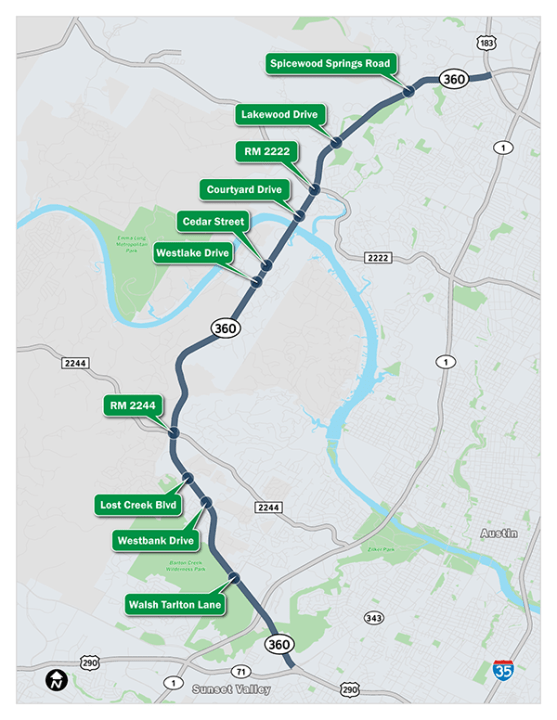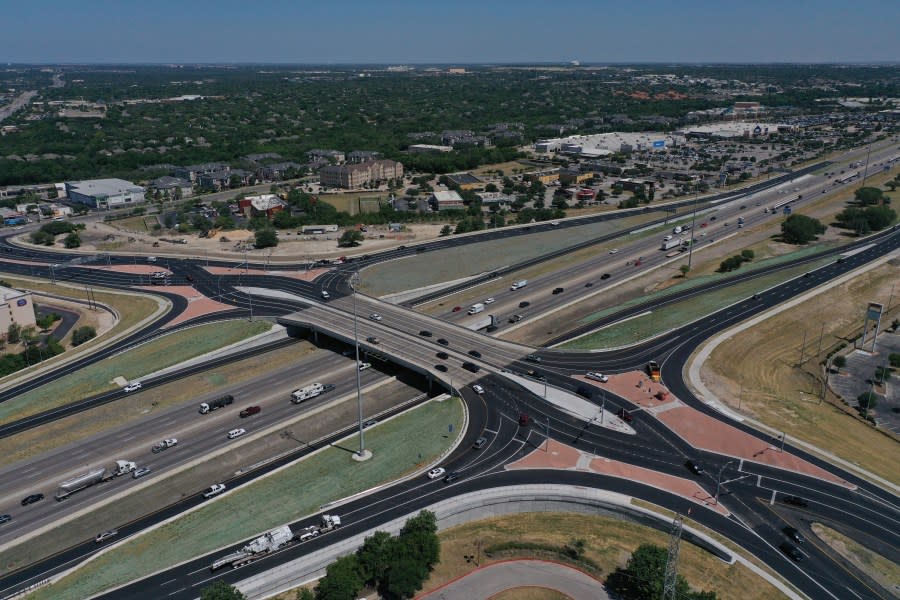Why some Loop 360 projects forge ahead while others stall

AUSTIN (KXAN) — For decades, Loop 360 has been a critical north-south corridor weaving through west and northwest Austin, offering connection points throughout the capital area region. But what’s the latest status on projects in development to alleviate congestion along the corridor?
What is the Loop 360 program?
The Texas Department of Transportation oversees the roadway. With Loop 360 being an essential corridor linking the western part of Austin with downtown as well as further north, TxDOT outlined a series of project areas experiencing high traffic congestion as well as traffic volume growth.
These projects aim to overhaul the roadways and alter traffic through patterns to improve mobility, with expanded pedestrian and cyclist features to enhance their access while also promoting safety.
The following key projects are outlined as part of this Loop 360 program:
Westlake Drive and Cedar Street
Lakewood Drive and Spicewood Springs Road
Courtyard Drive and RM 2222
MoPac Expressway to RM 2244
RM 2244

However, despite all the projects flagged, only a handful are in active development. Those lags in project development are often due to limited funding available, said Antonio Lujan, a TxDOT spokesperson.
“TxDOT has various projects that are underway, and it all depends on funding — when the funding comes in,” Lujan said. “And it’s just one of those things where they have to take projects by priority.”
That prioritization often comes down to a variety of factors, including area populations along with the amount of vehicular traffic movement along the corridor.
The Unified Transportation Program is the state’s 10-year outlook on the development and authorization of transportation construction projects. The 2024 UTP documents noted continuous congestion along Loop 360 as one of Austin’s traffic pinch points.
“With the population of the Austin metropolitan area rapidly increasing, congestion is becoming an even greater issue. To mitigate congestion, the Austin District is proposing upgrades to many of the area’s major roadways including, but not limited to, SH 71, US 281, SL 360 and RM 620. The Austin District continues to work with its regional partners to deliver mobility and safety improvements on other heavily traveled corridors under development including, but not limited to RM 1826, FM 812, and SH 29.”
2024 Unified Transportation Program
Four Loop 36 projects were flagged as part of the 2024 Unified Transportation Program. That program acts as the state’s blueprint and priority list of which projects are most essential and poised to receive funding within the next 10 years to help kickstart construction.
The 2024 UTP featured new funding authorizations from state officials, while others didn’t receive any additional funding earmarks.
Loop 360 intersection at Spicewood Springs Road
Estimated date range: Fiscal year 2028-2033
Construction cost estimate: $43.2 million
New funding authorization from the UTP
Loop 360 intersection at Courtyard Drive
Estimated date range: FY2024-2027
Construction cost estimate: $52.7 million
No funding changes from the UTP
Loop 360 intersection at RM 2222
Estimated date range: FY2024-2027
Construction cost estimate: $6 million
No funding changes from the UTP
Loop 360 intersection at Lakewood Drive
Estimated date range: FY2028-2033
Construction cost estimate: $46.9 million
New funding authorization from the UTP
How bad is Loop 360’s congestion compared to other roadways?
A look at the Texas A&M Transportation Institute’s 2023 rankings found Loop 360 between RM 2222 and RM 2244 was ranked No. 257 statewide for congestion levels. For perspective, it landed at No. 345 in Texas in 2022.
Research found Loop 360 is responsible for 62,685 hours’ worth of delays per mile each year. The costs of those congestion delays amount to nearly $8.2 million yearly, per TTI data.
For perspective, one portion of Interstate 35 in Austin landed in the top 10 for the most congested roadways in Texas last year. I-35 from U.S. 290 North and State Highway Spur 69 to Ben White Boulevard and State Highway 69 ranked No. 4 in 2023.
What work is currently underway within the Loop 360 program?
Right now, construction is underway along Loop 360 at Westlake Drive and Cedar Street and is expected to wrap in mid-2025, depending on weather. That project centers on removing traffic signals along the Loop 360 main lanes, and instead adding an underpass for main lanes to travel beneath the cross streets at both those locations.
loop360-westlake-drive-north-rendering-sept-2022Download
loop360-westlake-drive-renderings-cedar-street-sept-2022Download
For the Loop 360 project at Courtyard Drive and RM 2222, design work finished in 2023 and utility relocation work is ongoing. Construction was previously expected to kickstart in 2024, but is now expected to start in 2026, TxDOT officials confirmed.
That project will center on constructing a diverging diamond interchange at the RM 2222 intersection. At the Courtyard Drive intersection, TxDOT will remove the signals from the Loop 360 main lanes and instead construct an underpass.
Other enhancement elements for both projects included adding shared-use paths for improved pedestrian and cyclist mobility.
Other program projects in earlier development stages include the following:
MoPac Expressway to RM 2244: Removing traffic signals along the main lanes and adding either an overpass or underpass at Lost Creek Boulevard and Westbank Drive; construction for this project could begin around mid-2025
Lakewood Drive and Spicewood Springs Road: Removing traffic signals along the main lanes and adding overpasses at Lakewood Drive and Spicewood Springs Road as well as non-signalized U-turns in both directions; the project was environmentally cleared in 2023 and is undergoing its planning and design phases
RM 2244: Intersection improvements planned at RM 2244, including the possibility of a diverging diamond interchange; no set date for work to begin on this one
What’s the benefit of diverging diamond interchanges, overpasses and underpasses?
A common theme along the Loop 360 program’s projects include the presence of both overpasses and underpasses as well as diverging diamond interchanges. That’s an intentional design choice to help improve motorist safety, Lujan said.
“By removing all of the signals, you’re already creating an environment where people don’t have to get distracted by stopping at a signal light, trying to make sure that it’s their turn to proceed forward or make a left-hand turn or make a right,” he said. “And so you remove all of the local traffic to the frontage roads, and that actually allows people that live in the communities nearly to be able to commute to the schools or, you know, to have to go to the grocery store nearby.”
TxDOT officials said the diverging diamond interchanges can help promote continually flowing traffic to avoid congestion hang-ups. Those are particularly targeted at intersections with higher volumes of left-turning traffic.
A diverging diamond interchange temporarily relocates traffic to the left side of the road, allowing through traffic and left-turning traffic to travel concurrently.

“As our entire area of Central Texas continues to grow, we do have to find a way to mitigate with that growth and actually provide safety enhancements, so that drivers can be a lot safer out there on the roads as they are heading to their work or school, or heading home after work,” Lujan said.
For the latest news, weather, sports, and streaming video, head to KXAN Austin.

